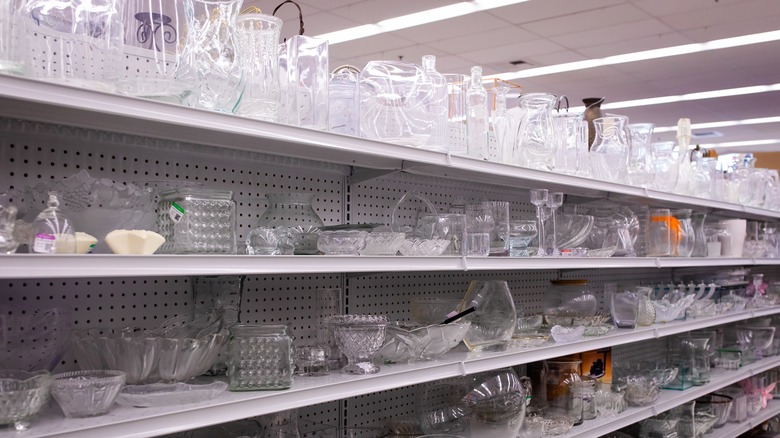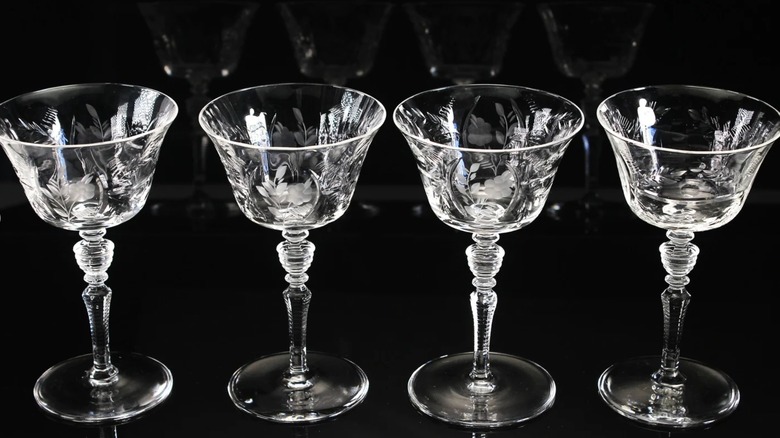The Valuable Depression-Era Glassware You Can Find At The Thrift (If You're Lucky)
We may receive a commission on purchases made from links.
As you browse the aisles of the thrift store never leave behind glassware as there are so many rare finds. Some of these pieces are must-have drinking vessels, but there is one antique that was popular not only in the early 20th century but centuries before that which you simply cannot pass on. Champagne coupes are the valuable, Depression-era glassware you can find at the thrift if you're lucky. The best way to determine if you scored is to check the stem and bowl.
Also known as Champagne saucers, these types of glasses were created in the 17th century to collect the sediment found in the bubbly beverage. Individuals would quickly drink it like a shot, flipping the cup over to let the minerals at the bottom flow out. It soared in popularity in France during the 18th and early 19th centuries, eventually spreading to the rest of Europe and America. During the '20s, you might see flappers with one in their hands.
However, it wasn't long before flutes had taken over since Champagne saucers caused the bubbles to disappear quickly. A revival emerged, especially in modern homes, as a unique option for cocktails. Over time, many glassmakers have produced these glasses (including Morgantown and Baccarat) which came in various colors, designs, and etchings. Once you have your secondhand finds, you need to know how to style them in your home, in your bar, or as a dessert table setting piece.
Check the stem and bowl to ensure you found real Champagne coupes
To know for certain you found antique champagne coupes, you need to check the stem and bowl for validation. The easiest way to know you found one of these beauties is by its hollow stem. Other champagne glasses have narrow stems where liquid or other materials cannot seep in. These stems have a wide enough opening for you to see while examining them at the store. They will vary in length, but many older versions have short, stout stems. When you pour champagne into these glasses, a fountain of bubbles will erupt from the stem opening, creating a fun experience for the drinker.
You can differentiate these glasses from the others based on their wide, shallow bowl which can just as easily hold desserts like ice cream, pudding, or custard. Due to the size of the bowl, users can easily sip their beverage without tilting, which is ideal for situations where people are trying to talk and hold eye contact. If you're familiar with vintage brands and glassware companies, you can also look for etchings at the bottom of the glass for maker's marks or other indicators. If you need help authenticating your latest thrifting find, reach out to an appraiser or glassware expert to ensure you have a piece from the era.
Styling Champagne coupes in your home
While you can make some serious dough on some of these sets, you can't miss out on the opportunity to style them in your own home, in your bar area, or even as a dessert table setting. With their unique, retro appearance, these pieces are a funky addition that works for any bar. Most sets come with four to six glasses, making them a great collection to have on hand for when you entertain guests. Thanks to their size, they are easy to stack to create a stunning champagne tower during a birthday or New Year's Eve party.
Due to their wide bowls, you don't have to use them just for drinking; they also work well to hold yummy, sweet treats. As you set up a dessert table after dinner, you can't forget to add these glasses to the table. They can also serve as a way to decorate the home for Valentine's Day, creating a romantic scene. Remember that they're delicate glassware, so hand-wash them only. Before you consume or drink out of them test them for lead and arsenic since some glasses produced during this era were formulated with these components. If you like the design but don't want to risk getting sick, there are many modern renditions. For any antiques that do have toxins, you can always keep them as display pieces.


